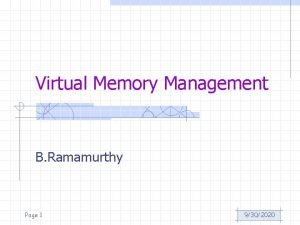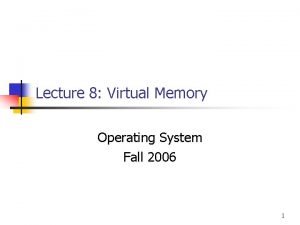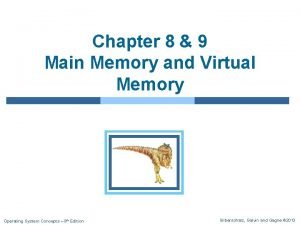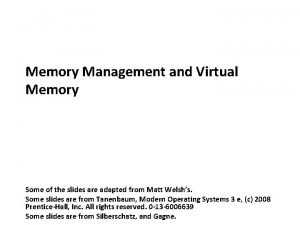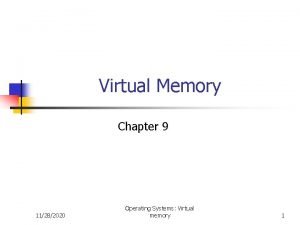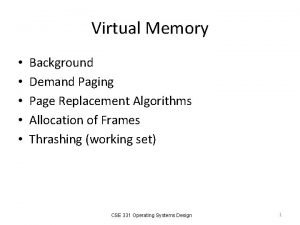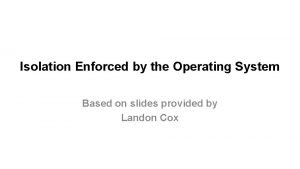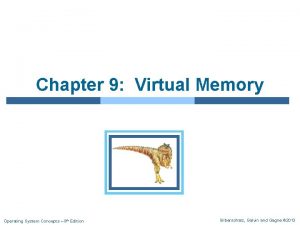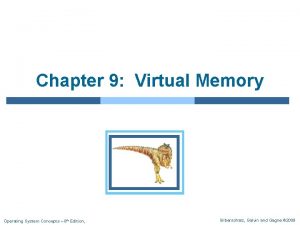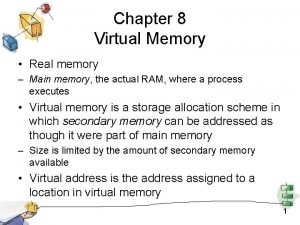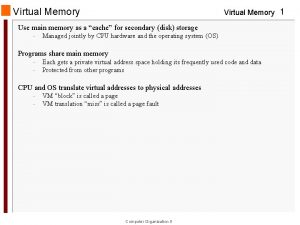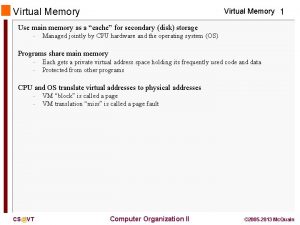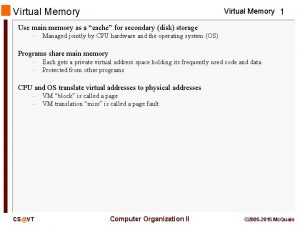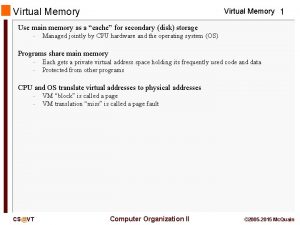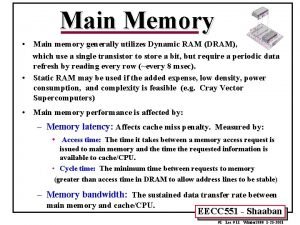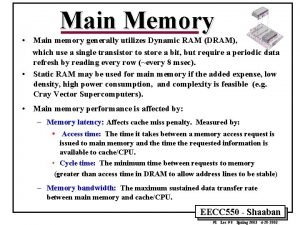Virtual Memory 1 Use main memory as a



















- Slides: 19

Virtual Memory 1 Use main memory as a “cache” for secondary (disk) storage – Managed jointly by CPU hardware and the operating system (OS) Programs share main memory – – Each gets a private virtual address space holding its frequently used code and data Protected from other programs CPU and OS translate virtual addresses to physical addresses – – CS@VT VM “block” is called a page VM translation “miss” is called a page fault Computer Organization II © 2005 -2015 Mc. Quain

Paging to/from Disk Virtual Memory 2 Idea: hold only those data in physical memory that are actually accessed by a process Maintain map for each process { virtual addresses } { physical addresses } { disk addresses } OS manages mapping, decides which virtual addresses map to physical (if allocated) and which to disk Disk addresses include: – – – Executable. text, initialized data Swap space (typically lazily allocated) Memory-mapped (mmap’d) files (see example) Demand paging: bring data in from disk lazily, on first access – CS@VT Unbeknownst to application Computer Organization II © 2005 -2015 Mc. Quain

Process Virtual Memory Image OS maintains structure of each process’s %esp address space – which addresses are valid, what do they refer to, even those that aren’t in main memory currently Virtual Memory 3 Backed by kernel virtual memory Not paged, or swap file stack swap file Memory mapped region for shared libraries run-time heap (via malloc) uninitialized data (. bss) initialized data (. data) program text (. text) code: shared. so file data: swap file (*) swap file (*) executable 0 CS@VT Computer Organization II © 2005 -2015 Mc. Quain

Address Translation Virtual Memory 4 Fixed-size pages (e. g. , 4 KB) Swap file CS@VT Computer Organization II © 2005 -2015 Mc. Quain

Page Fault Penalty Virtual Memory 5 On page fault, the page must be fetched from disk – – Takes millions of clock cycles Handled by OS code Try to minimize page fault rate – – Fully associative placement Smart replacement algorithms How bad is that? Assume a 3 GHz clock rate. Then 1 million clock cycles would take 1/3000 seconds or 1/3 ms. Subjectively, a single page fault would not be noticed… but page faults can add up. We must try to minimize the number of page faults. CS@VT Computer Organization II © 2005 -2015 Mc. Quain

Page Tables Virtual Memory 6 Stores placement information – – Array of page table entries, indexed by virtual page number Page table register in CPU points to page table in physical memory If page is present in memory – – PTE stores the physical page number Plus other status bits (referenced, dirty, …) If page is not present – CS@VT PTE can refer to location in swap space on disk Computer Organization II © 2005 -2015 Mc. Quain

Translation Using a Page Table Virtual Memory 7 1 2 3 5 4 CS@VT Computer Organization II © 2005 -2015 Mc. Quain

Mapping Pages to Storage CS@VT Computer Organization II Virtual Memory 8 © 2005 -2015 Mc. Quain

Replacement and Writes Virtual Memory 9 To reduce page fault rate, prefer least-recently used (LRU) replacement (or approximation) – – – Reference bit (aka use bit) in PTE set to 1 on access to page Periodically cleared to 0 by OS A page with reference bit = 0 has not been used recently Disk writes take millions of cycles – – CS@VT Block at once, not individual locations Write through is impractical Use write-back Dirty bit in PTE set when page is written Computer Organization II © 2005 -2015 Mc. Quain

Fast Translation Using a TLB Virtual Memory 10 Address translation would appear to require extra memory references – – One to access the PTE Then the actual memory access Can't afford to keep them all at the processor level. But access to page tables has good locality – – CS@VT So use a fast cache of PTEs within the CPU Called a Translation Look-aside Buffer (TLB) Typical: 16– 512 PTEs, 0. 5– 1 cycle for hit, 10– 100 cycles for miss, 0. 01%– 1% miss rate Misses could be handled by hardware or software Computer Organization II © 2005 -2015 Mc. Quain

Fast Translation Using a TLB CS@VT Computer Organization II Virtual Memory 11 © 2005 -2015 Mc. Quain

TLB Misses Virtual Memory 12 If page is in memory – – Load the PTE from memory and retry Could be handled in hardware n – Can get complex for more complicated page table structures Or in software n Raise a special exception, with optimized handler If page is not in memory (page fault) – – CS@VT OS handles fetching the page and updating the page table Then restart the faulting instruction Computer Organization II © 2005 -2015 Mc. Quain

TLB Miss Handler Virtual Memory 13 TLB miss indicates whether – – Page present, but PTE not in TLB Page not present Must recognize TLB miss before destination register overwritten – Raise exception Handler copies PTE from memory to TLB – – CS@VT Then restarts instruction If page not present, page fault will occur Computer Organization II © 2005 -2015 Mc. Quain

Page Fault Handler Virtual Memory 14 Use faulting virtual address to find PTE Locate page on disk Choose page to replace – If dirty, write to disk first Read page into memory and update page table Make process runnable again – CS@VT Restart from faulting instruction Computer Organization II © 2005 -2015 Mc. Quain

TLB and Cache Interaction Virtual Memory 15 If cache tag uses physical address – Need to translate before cache lookup Alternative: use virtual address tag – Complications due to aliasing n CS@VT Computer Organization II Different virtual addresses for shared physical address © 2005 -2015 Mc. Quain

Memory Protection Virtual Memory 16 Different tasks can share parts of their virtual address spaces – – But need to protect against errant access Requires OS assistance Hardware support for OS protection – – CS@VT Privileged supervisor mode (aka kernel mode) Privileged instructions Page tables and other state information only accessible in supervisor mode System call exception (e. g. , syscall in MIPS) Computer Organization II © 2005 -2015 Mc. Quain

Multilevel On-Chip Caches Virtual Memory 17 Intel Nehalem 4 -core processor Per core: 32 KB L 1 I-cache, 32 KB L 1 D-cache, 512 KB L 2 cache CS@VT Computer Organization II © 2005 -2015 Mc. Quain

2 -Level TLB Organization Virtual Memory 18 Intel Nehalem AMD Opteron X 4 Virtual addr 48 bits Physical addr 44 bits 48 bits Page size 4 KB, 2/4 MB L 1 TLB (per core) L 1 I-TLB: 128 entries for small pages, 7 per thread (2×) for large pages L 1 D-TLB: 64 entries for small pages, 32 for large pages Both 4 -way, LRU replacement L 1 I-TLB: 48 entries L 1 D-TLB: 48 entries Both fully associative, LRU replacement L 2 TLB (per core) Single L 2 TLB: 512 entries 4 -way, LRU replacement L 2 I-TLB: 512 entries L 2 D-TLB: 512 entries Both 4 -way, round-robin LRU TLB misses Handled in hardware CS@VT Computer Organization II © 2005 -2015 Mc. Quain

Nehalem Overview CS@VT Virtual Memory 19 Computer Organization II © 2005 -2015 Mc. Quain
 Virtual memory
Virtual memory Virtual memory in memory hierarchy consists of
Virtual memory in memory hierarchy consists of Has virtual functions and accessible non-virtual destructor
Has virtual functions and accessible non-virtual destructor Virtual memory
Virtual memory Aging algorithm
Aging algorithm Virtual memory in os
Virtual memory in os Virtual memory in operating system
Virtual memory in operating system Virtual memory advantages
Virtual memory advantages Explain virtual memory in computer architecture
Explain virtual memory in computer architecture Demand paging in virtual memory
Demand paging in virtual memory Virtual memory in os
Virtual memory in os Virtual memory linux
Virtual memory linux Virtual memory os
Virtual memory os Virtual memory
Virtual memory Virtual memory segmentation
Virtual memory segmentation Dram memory mapping
Dram memory mapping Virtual memory os
Virtual memory os Virtual memory os
Virtual memory os Virtual memory is commonly implemented by
Virtual memory is commonly implemented by Slab is one or more physically contiguous frames.
Slab is one or more physically contiguous frames.




